Pre-cut copper bar stock. From here the copper will be turned to the desired diameter for the projectile being made and then multiple projectiles will be manufactured from each.
By Christopher R. Bartocci
Like firearms, ammunition hits a peak of development and levels off. Once in a while, something really new hits the market. Back in 1991, Winchester Black Talon was introduced to the market and there was an outcry from gun control advocates and some medical personnel that his round was too lethal and should be banned because of its excessive destructive nature. At what point do we really say any ammunition is too dangerous? The purpose of a defensive bullet is to stop the threat. There are different ways to do that such as by destroying major blood vessels and lungs and heart and this is accomplished by using a projectile that destroys tissue. Full metal jacket projectiles do this by punching holes in them; hollow point projectiles do this by destroying tissue as they expand. The more the projectile fragments the more separate wound channels are made thus more tissue is destroyed with an end result in stopping the threat. Some projectiles do this better than others. Anyone who has studied the theory and application of wound ballistics knows that there is no magic bullet. There is no magic caliber either.
Interestingly, one would be surprised how often hollow point projectile do not open up as designed. There are many factors; this includes initial barriers such as glass, wood, drywall and most importantly clothing. Hollow point projectiles can become clogged with clothing (cotton, denim, polyester, etc.) that will prevent them from opening and also depending on the density of the tissue the bullet strikes. Harder muscle and bones for instance can affect the opening of a projectile. Then straight soft tissue hits can open projectiles up as designed. It would not be uncommon at all to have multiple shots and have only 20% of the projectiles actually mushroom as designed due to all of these potential variables. With that being said, some believe in the single projectile that retains all of its weight and expands nearly double in diameter as the way to go where others believe in fragmentation. Leave that up to the individual to decide. However, from the standpoint of physiology, the more tissue destroyed the more apt you are to stop an attacker.
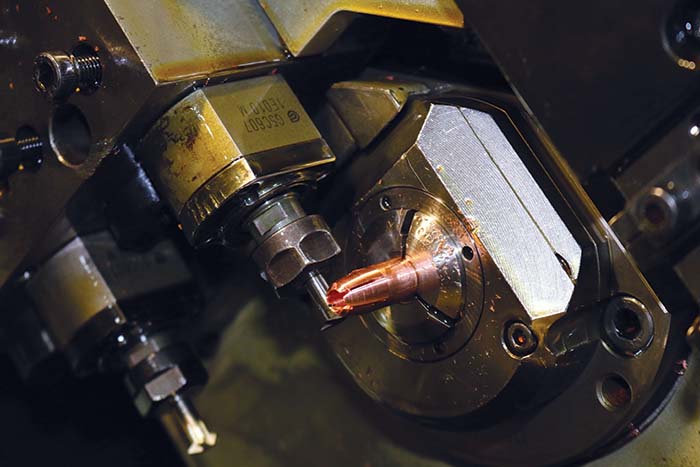
Bullet manufacturing and development has taken a direction away from lead in the area of high performance hollow point ammunition beginning with solid copper Barnes bullets – made in both rifle and pistol rounds. Originally developed in high caliber rifle rounds for deep penetration in heavy to dangerous game, the solid copper projectile now make up some very good pistol projectiles including the Barnes TAC-TX. Machined/CNC machined projectiles from solid copper rod or different material were first seen with LeHigh Defense. These projectiles seemed extremely effective but expensive. Then again this is not target shooting ammo.
The newest, opening their doors late in 2013, is G2 Research with The RIP (Radically Invasive Projectile). This is quite different from anything that has been done in the past. What truly sets this projectile apart from the rest is explained by Chris Nix of G2 Research
“Like LeHigh Defense, the design has features that are precision machined from a solid copper bar. These machined geometries create weaker cross sections that fail or fracture predictably under certain loads. Where we differ is that our machined features are not just engineered to create weak points in the structure. Geometry is the key variable in the concept of this technology. The trocars and other machined features play a significant role in barrier penetration and where the energy is dissipated. There is a moment in time in which this piercing action transfers from one medium to the next with less resistance thus retaining energy in the form of velocity. Through hard, semi hard and soft mediums, the projectile’s performance is optimized by the result of how the geometry is presented relative to its direction of travel. It is evident in hard barrier testing like sheet metal that the punctured hole is cleaner and if the sheet metal is unconstrained you can observe that it falls over like a domino instead of being knocked down. What is happening here is the barrier is being defeated with less energy loss.
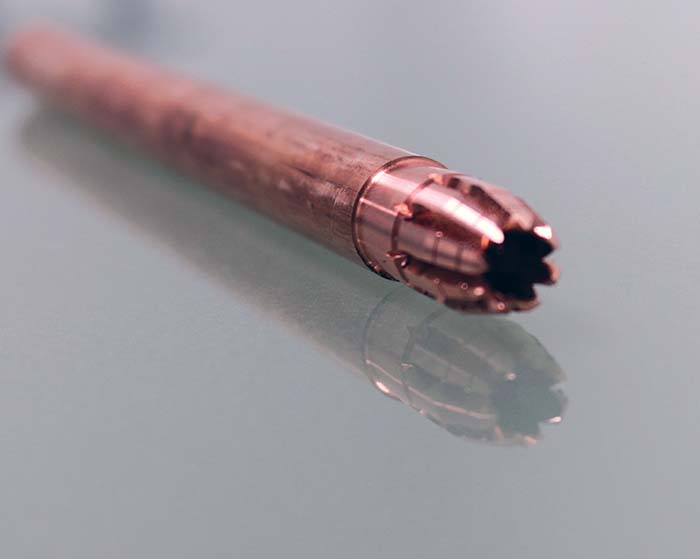
“The 45 degree autoglass test shows trajectory being retained as a result of this application of technology. In fact in the real world the angles of presentation are quite compounded and variable as is the resistance at point of impact of that medium. To better explain in a real world defense situation a law enforcement officer may not stand directly in front of the vehicle that is trying to run them over especially if given the opportunity to move. Different makes of vehicles yield a lottery of curvature and geometrical differences. If the vector of shot places the trajectory’s path intersecting the surface of the windshield closer to the corners verses the center, this can make a difference in resistance too. With G2 Research’s design there is a broader range of angles where the round maintains trajectory. Your more conventional projectile shape shows a higher propensity to glance as its rounded nose is presented to these types of obstacles at lesser angles. To incapacitate the threat you must hit it and under distress shooting as described shot placement will be compromised enough.
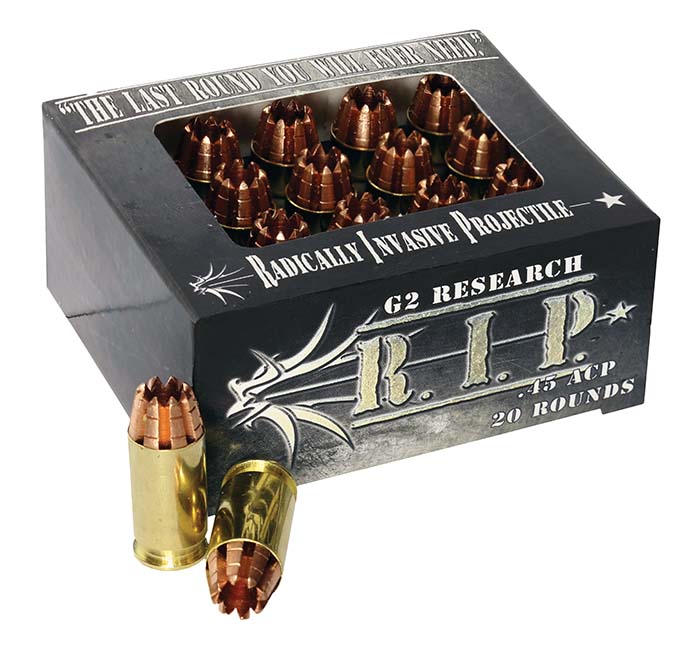
“The heavy clothing test defined by the FBI is 4 layers of heavy denim. What we test for here is that the round will penetrate this barrier and still perform its expansion or fracture (depending on the product) through this medium. During development we found that our design would very consistently perform this requirement. So our team decided to amp the test up a little to see where we drop off in performance. The results compared to other rounds were quite amazing and it was evident that we were on to something. The large cavity along with the other geometries mentioned work together to prevent clogging that would otherwise impede its performance. The results were 12 plus layers. In real world scenarios it’s not impractical to create the equivalent of more than 4 layers of denim especially in colder climates.
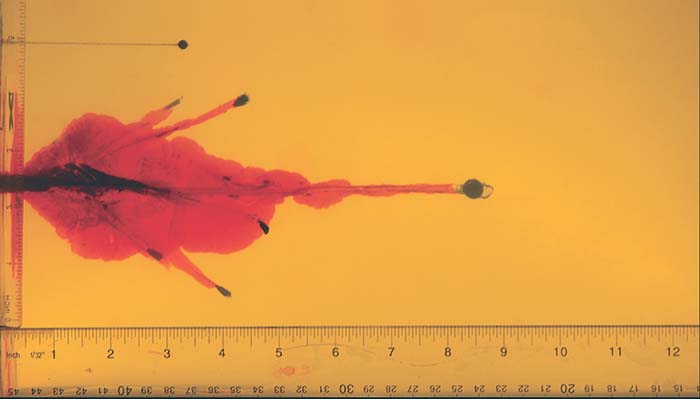
In this author’s opinion, the most impressive of all loads was the .380 Auto load. This 62 grain projectile was fired at a velocity of 1,238 feet per second. Of the initial 62 grain weight, approximately 62% of the original weight was retained. The trocar penetration was from 2 3/4 to 4 3/4 inches in depth and the projectile core penetrated 8 3/4 inches.
“Once the round has entered soft tissue targets the geometry is still working for us. Another difference that exists between us and some other machined solid copper projectiles is the cuts along the axis of the projectile do not go into the hollow point. An increased rate of radial pressure built from fluid or tissue is a result of the reduced deceleration at impact mentioned earlier. These hydrostatic forces are contained inside the cylinder until the hoop strength of the material fails. When the failure along the axis occurs it is quite mechanically explosive. Each petal inside the soft target will carry its wave of energy after they’ve fractured and traveled along their predictable paths. This conical disbursement of 8 trocars are approximately 60 degrees of included angle. Each of the 8 trocars path along that 60 degree conical are an approximate radial increment of 45 degrees. This creates a wave of energy that is very easy to witness in the slow motion segments of the gel shots other than the temporary wound cavity resulting from these now individual projectiles energy push. Their shape is designed to slice through muscle tissue, arteries and organs with less resistance. Our 8 petal versus 3 petals increases the probability of one of those fragments compromising a vital, thus increasing odds of incapacitation per shot by a factor of 2.66. Especially if shot placement isn’t perfect under a distress real world self-defense situation.
“We all play by the same rules and constraints regarding SAAMI specifications for loading of OAL, diameters and pressures, materials available, choices in brass, primer and powder technologies. 1/2 MV^2= Ke
“What this has done is created a seesaw between Mass and Velocity as many manufactures have juggled those two variables to achieve similar results of the predicate.
“With this new and radical approach to geometry, G2 Research has introduced a new variable that allows the energy to be put more where
it is intended.”
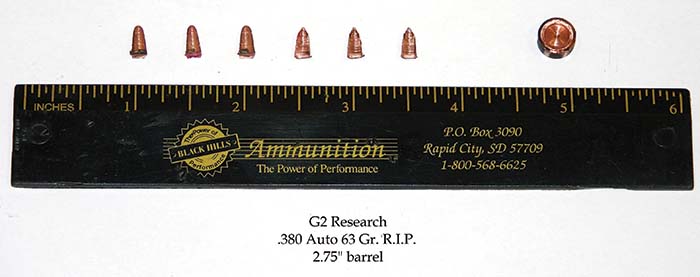
The research and development at G2 is continuously on-going and geared for new products. The RIP projectile was more than a year in development. Manufacturing starts off with a single copper bar that is 12 feet long and depending on the caliber gets 147 to 238 projectiles. The CNC machine manufactures a projectile from the end of the copper bar. Each projectile takes about 20 to 50 seconds to manufacture depending upon the caliber. That round is cut at the base, falls in a bucket and the next projectile is made. The process continues until the bar is used up.
Outside loading is used. G2 build the components to adapt their machines to load the G2 projectiles. G2 has a very strict quality control and testing policies in place for anything loaded by their vendors. G2 outsources brass, powder and primers. All the ammunition is subjected to SAAMI specifications. The accuracy requirement is 2 inches at 25 yards. These are not designed for target shooting or match accuracy; they are designed for an up close protection round. Currently, G2 offers the RIP projectile in calibers .380 Auto, 9x19mm, .357 SIG, .40 cal. and .45 Auto.
Samples of .380 Auto, 9mm, .40 and .45 Auto were provided to SAR for test and evaluation. We at SAR do not like to take anyone’s word for how a product functions or works, we like to test it ourselves. There were 4 gel blocks made up to FMI standards. The gel blocks were calibrated with a BB fired at 589 feet per second.
The .380 Auto was the first tested. The gel was calibrated with a single BB fired at 589 feet per second with a depth of 3.34 inches. The 62 grain round was fired in a Ruger LCP with a 2.75 inch barrel at a muzzle velocity of 1,238 feet per second. The total cavity length was 4.875 inches. The trocars penetrated at 360° from 2 3/4 to 5 inches as advertised. The core penetrated 8.75 inches. The projectile retained 62% of its weight. This was without a doubt the most impressive result.
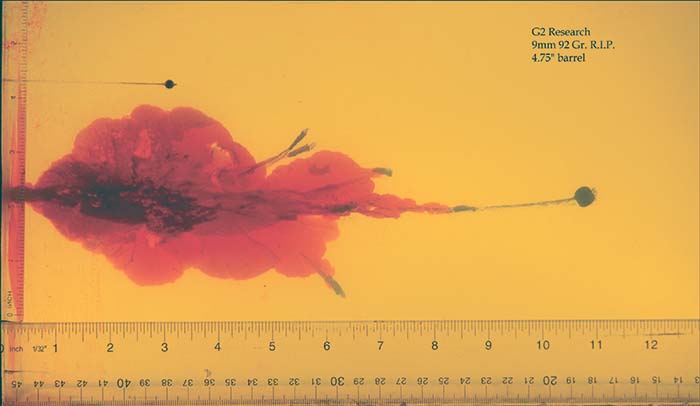
The 9mm projectile is a 92 grain projectile fired at a velocity of 1,347 feet per second. The trocar penetration was 5 1/4 to 8 3/4 inches with the core stopping at 11.12 inches
The 9x19mm was next. The gel was calibrated with a single BB fired at 590 feet per second with a depth of 3.14 inches. The 92 grain round was fired in a Browning Hi-Power with a 4.75 inch barrel at a muzzle velocity of 1,347 feet per second. The total cavity length was 7 inches. The trocars penetrated at 360° from 5 to 7 inches in depth. The core penetrated 11.125 inches. The projectile retained 49% of its weight with an average expansion diameter of .366 inches with the largest being .373 inches.
Next was the .40 caliber. The gel was calibrated with a single BB and fired at 578 feet per second with a depth of 3.24 inches. The 115gr round was fired in a Glock 22 with a 4.49 inch barrel at a muzzle velocity of 1,164 feet per second. The total cavity length was 4.75 inches. The trocars penetrated at 360° from 5 to 6 inches in depth. The core penetrated 9.5 inches. The projectile retained 45.1% of its weight with an average expansion diameter of .400 inches.
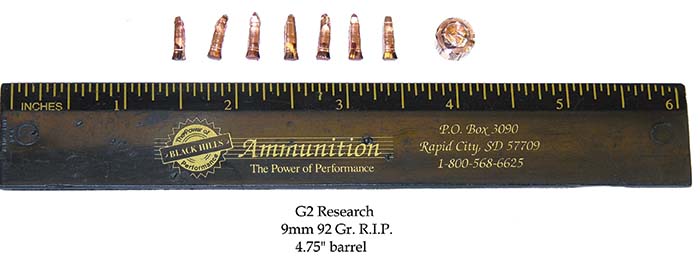
Lastly was the .45 Auto. The gel was calibrated with a single BB and fired at 576 feet per second with a depth of 2.97 inches. The 158 grain projectile was fired in a Springfield Armory M1911A1 with a 5 inch barrel at a muzzle velocity of 1,024 feet per second. The total cavity length was 5.75 inches. The trocars penetrated at 360° from 5.5 to 8 inches in depth. The core penetrated 10.75 inches. The projectile retained 52% of its original weight with the average expansion diameter of .450 inches.
All rounds fired performed as advertised. All trocars broke off in aradial pattern creating multiple wound channels. Gel is not the end all of testing. It takes into account the simulation of soft tissue. It does not take into account the density of muscle and harder tissues found in various organs nor bone. We were limited on gel blocks so it was not possible to test for the other variables. Based on the gel testing the projectile does appear to be extremely effective. Depending on the caliber there are 7 to 9 separate wound channels. This drastically increases the chance of hitting a vital organ with a single shot and stopping the target as opposed to a single projectile.
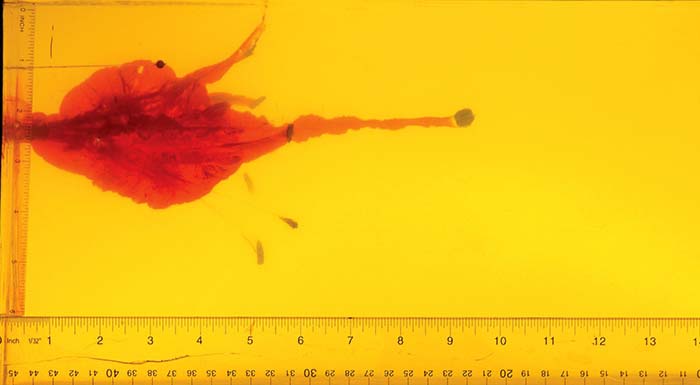
The .40 caliber projectile is a 115 grain projectile fired at a velocity of 1,164 feet per second. The trocar penetration was 5 to 6 inches with the core penetrating 9.5 inches in depth.
Not unlike Winchester’s Black Talon, G2 has received bad press for making an evil devastating projectile.
Chris Nix of G2 continues: “Not official, but there are two sides of this coin on the internet. There are people that make claims that we are the most destructive ammo ever developed and we should all burn in hell for creating such a thing. The other side says that the ammo is a gimmick round that has absolutely no power for defensive and we should burn in hell for our marketing. The people who actually test the ammo for themselves realize that we are an incremental step in the evolution of modern ammunition and we will continue to research and develop its evolution.
“We believe that at this stage many people are trying new forms of defense with lead free projectiles and so far no one has created a round that we would be scared to carry in our own guns. We believe our round is more efficient in certain aspects of its life cycle and in the arena of self-defense, any advantage is a good advantage.”
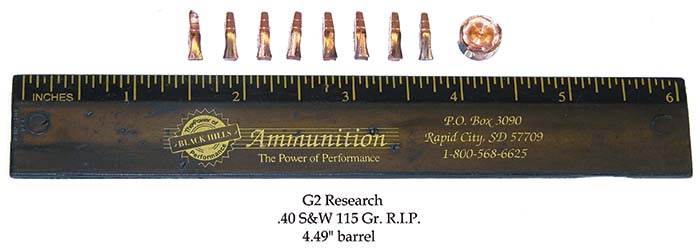
Another line of ammunition recently introduced by G2 is their VIP (Visually Indicated Projectile) based on cold tracer technology.
According to Chris Nix, “Our VIP uses a cold tracer technology that nullifies the incendiary and toxic qualities of the common tracer using a proprietary technology affixed to the back of the projectile. The particular light glow of the powder we use in the round lights the back of the projectile much like the glow in the dark stickers that we are all familiar with. Our Cold Tracer is meant for low light conditions where the trace could help to quicker get on target in a panic situation or as a training round that the instructor can see. Unlike, traditional tracers the vector of light emitted from the VIP is axial to the projectile, which means the light is coming off the tail end. This makes the illumination only visible from an approximated 15 degree included angle from the shooter’s point of view. No one outside that field of view can see the light trail therefore not compromising the shooter’s position.”
As of this writing the VIP is only available in 9mm but soon to be introduced in .45 Auto. Due to the cold tracer technology, the VIP round is safe to use indoors and will not set a fire to a dry range.
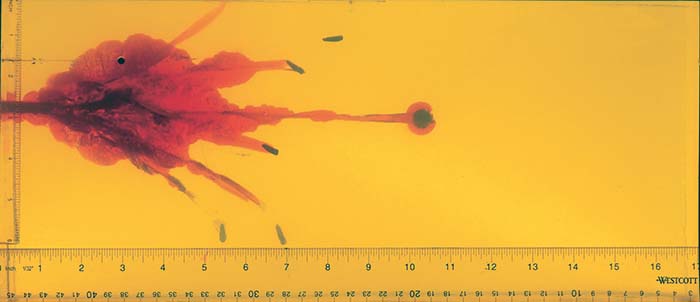
The .45 caliber projectile weighs 158 grains and fired at a velocity of 1,024 feet per second. The trocar penetration was 5 1/2 to 8 1/2 inches. The core penetrated 10.75 inches.
G2 also offers rifle ammunition in both super and subsonic .300 Blackout as well as .223 Rem. The Trident is a precision CNC machined, lead free, solid copper projectile engineered to expand to nearly 3 times its original diameter while maintaining almost 100% of its initial weight. Each Trident projectile is engineered to expand in a predetermined velocity range. As an example, a competing .30 cal. 150 grain projectile will expand at velocities in excess of 2,600 fps when fired from a .308 rifle, but when the same 150 grain projectile is used in a .300 blackout, the performance is less than ideal. Since each projectile is individually machined, G2 can tailor the performance to the specific application. While some companies take a bigger is always better approach, the Trident rounds are optimized for expansion as well as penetration to provide the optimum in energy transfer. Additionally, the Trident round only expands when it contacts tissue, so it is suppressor safe. While the Trident round was specifically designed for hunting, it is equally effective as a self-defense round. The Trident will penetrate clothing and heavy denim and expand as designed on soft targets, yet still retain its mass as it punches through solid barriers such as drywall, sheet metal and auto glass.
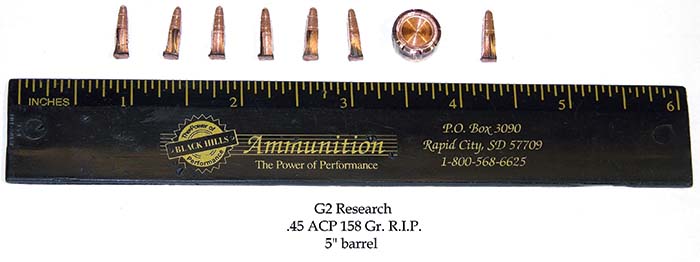
The RIP, VIP and Trident lines of ammunition are certainly a new take on ammunition mating high-tech manufacturing to projectiles. With a MSRP ranging from $49.99 to $59.99, you will not be target shooting with it. This will go in the magazine of your personal defense handgun or rifle. Only time will tell how effective this is on an assailant. But from a concept, execution and testing it appears as this will take its place alongside other well established personal defense rounds.
| This article first appeared in Small Arms Review V19N7 (September 2015) |











